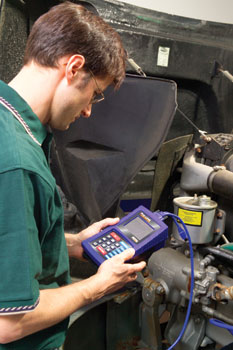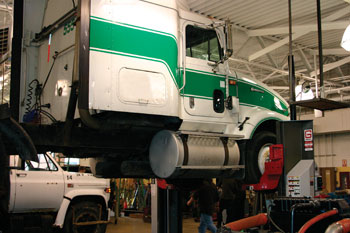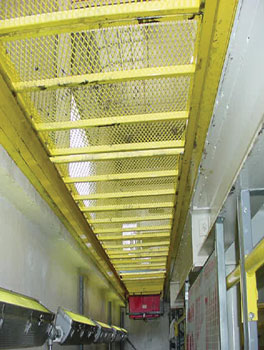 Adapted from Tom Gelinas’ article in Fleet Equipment
Adapted from Tom Gelinas’ article in Fleet Equipment
Tech Expectations
It was almost 10 years ago that USA Today ran an article titled “High-tech skills give auto mechanics more power.” In the article was a reference to a graduate from the automotive maintenance program of a technical college who was hoping to find a job for $25,000 to $30,000 after a worrisome search. Wasn’t he surprised when more than one dealer offered him a signing bonus along with an annual salary close to $40,000 with unexpected fringes?
The USA Today article did mention that the companies making those kind of offers were automobile companies, not trucking firms. It was BMW, for example, that made the offer of a position paying $38,000 per year, a $1,500 signing bonus, help in finding an apartment and additional specialized training.
It was also about 10 years ago when a well respected fleet manager added a personal story to a discussion about reasons for a shortage of diesel technicians. He told the tale of a young automobile technician who got paid for changing into a clean company-supplied uniform.
He then went to work in a comfortably heated and well-lighted service bay that was cleaned the night before by an outside janitorial service. He had the opportunity to work as much overtime as he wanted and, as a result, was able to earn upwards of $90,000 annually. When he was ready to go home, he was paid a half hour to shower and change back into his own clothes. The narrative was likely accurate as it turned out that the young man was our narrator’s son-in-law.
 So what’s this nonsense about a shortage of technicians? With numbers like that, who would expect that there might be any kind of shortage of maintenance technicians? Most graduates with bachelor’s degrees only hope for jobs like that, and most aren’t courted when they graduate.
So what’s this nonsense about a shortage of technicians? With numbers like that, who would expect that there might be any kind of shortage of maintenance technicians? Most graduates with bachelor’s degrees only hope for jobs like that, and most aren’t courted when they graduate.
Common Characteristics
Could it be there’s some kind of not-too-obvious difference between the value of automobile technicians and truck technicians? It certainly seems that a person who might aspire to work on trucks would have the same kind of interests as one that might want to work on cars.
The difference seems to lie primarily in one’s point of view. Some believe that the industry may not really have a shortage if we were able to change that viewpoint. Darry Stuart, president and CEO of DWS Fleet Management Services and the current general chairperson of the Technology and Maintenance Council, says, “I don’t necessarily believe that there is an overall shortage of truck technicians. I do believe we have an issue in developing and retaining them.
"Technicians in the oil fields in Canada make upwards of $200,000 a year. If you go to a Cadillac dealership, you’ll find technicians earning $80,000 to $100,000 annually. You can find that an automobile technician can make $80,000 a year, and we find that the industry will pay a truck mechanic $50,000.”
Managing Technology
Stuart’s concern about compensation levels is certainly valid, but even he says it’s not all about money. It’s much more about being happy, proud and secure. A recent
industry research study indicated that the two greatest challenges the trucking industry will face in the coming years is a shortage of qualified personnel and responding to advances in technology.
And, it’s very important for those in the industry to understand that many management techniques that once worked well in the past may no longer be effective in dealing with a workforce made up of 18- to 25-year-olds, a group he calls the Nintendo Generation. These are a segment of people, like many of you, that grew up playing video games on fast computers and experiencing the high rates of positive reinforcement such games provide.
Stuart said there is a lot to cover in the issues of management, but most of his concerns can be lumped under the general heading of lack of managerial training.
The example – Too often a technician gets promoted to his next level because he or she performs better in the shop than his or her peers. This continues until a new shop foreman or director of maintenance is needed. A shop will take its best technician and make that last promotion up to his or her level of incompetence. In a single step, they’ve taken their best technician off the floor and likely messed up operations.
It would be tough to blame the new boss. He was never groomed to be a manager. He doesn’t understand that you can get far more done with a carrot than with a stick. Too often, sarcasm is the favored tool of a manager. When there are shop meetings, does he try to establish a relaxed atmosphere or is there tension in the air?
Maybe a couple of pizzas would help. It’s much easier for staff members to talk openly when the atmosphere is relaxed. Only if a manager understands a problem can he try to solve it.
‘Environmental’ Issues to Look For
Stuart also addresses the shop’s working environment. Remember, it’s not always about the money – it’s about being proud, happy and secure.
When looking for employment in the fleet industry, look for a business that can provide a warm, clean, well-lighted shop.
Check to see if they have enough heaters to keep the temperature comfortable all the way to the shop floor, and is that floor clean.
Remember that as a fleet technician, often you are often working on you back. Seek a company that supplies shop tools and equipment –– diagnostic tools, floor jacks, drop lights, bench grinders, shop air systems, presses, vises, etc. –– in safe condition and good working order.
Too often when something goes missing or breaks, technicians simply don’t have the time to look for it or repair a broken item. Talk to the management personnel to see if the company has an established procedure for techs to report shop equipment problems and if these problems will be quickly corrected.
And finally, check into if the company you’re interviewing with has secure lockers and a clean locker room for technicians in which they can shower and change clothes.
Just as comfortable cabs and well-maintained equipment help retain drivers, shop technicians like yourself will appreciate a clean, well-lighted work environment.
 Helping Techs Stay On
Helping Techs Stay On
As long as employees know that their compensation is competitive, that they are fairly paid for overtime and receive differentials for undesirable shifts, they generally won’t leave a position for an incremental pay increase.
Stuart tells us that good technicians aren’t looking for all that much. They want opportunities for training, and they should be paid for mandatory training sessions. They want to work in a clean and safe environment for a solid company. They appreciate recognition for accomplishments and a reasonable work schedule. They want a good supervisor who listens when they have something to say.
 Many say that the fleet technician industry is fortunate to have many opportunities for technician training. For one of the most extensive resources available, go to
Many say that the fleet technician industry is fortunate to have many opportunities for technician training. For one of the most extensive resources available, go to
www.fleetequipmentmag.com and click on the “Equipment Directory” button on the left side of the home page.
There are many companies that provide wide-ranging material on the web.
Technicians need to know that they can grow in the company. A simple pat on the back goes a long way, but fleet managers need to do more.
Team Mentality
Southeastern Freight Lines, based in Columbia, SC, has a reputation for being an excellent employer, so we called the fleet’s manager of technical services, Jim Boyd. His first reaction was to say, “The loss of an employee is devastating to us, but, frankly, it’s very rare for someone to leave us.”
He went on to describe many programs that will most certainly keep their employees at the fleet, but more importantly, are designed to help their technicians grow professionally and make them feel more a part of a team.
These programs can broadly be organized into training, recognition and communications –– only parts of which can be described here, because each is quite extensive.
Training: One of a number training programs Southeastern offers is called ACE Certification. The acronym, which stands for Associate Continuing Education, is comprised of 16 self-paced modules on a variety of subjects.
Technicians study the ACE material on their own time and then take an on-line test on company time. After passing all 16 modules he or she is certified for three years; then the program must be repeated. New material is regularly added and updated as needed in the modules.
Recognition: Below are just a few of the formal programs designed to recognize employee accomplishments.
• Every year, 16 technicians from throughout the system are invited to come to Columbia to compete in the company’s own skills contest.
• Every year, two technicians are sponsored at the Technology and Maintenance Council’s SuperTech contest.
• The fleet holds regular cookouts for shops that have achieved six months without any on-the-job incidents.
• The fleet sponsors technicians in state and local maintenance activities.
• The company has employee-of-the-month, employee-of-the-quarter and employee-of-the-year awards.
Communications: Among the various communications activities at Southeastern is its Survey, Discuss and Implement (SDI) program. This is an annual opportunity to grade both his or her supervisor and the company, and, according to Boyd, these ratings are taken very seriously. In fact, a supervisor who falls below a given level is required to prepare a plan of action designed to make sure the score is corrected the following year.
Boyd says, “The use of the training that is provided in conjunction with our diagnostic capabilities empowers our technicians to make the proper diagnosis and repair of problems. This creates a sense of accomplishment and professionalism. We see ‘team building’ going on in many locations. The associates seem to feed off of each other, creating a new sense of accomplishment.”


